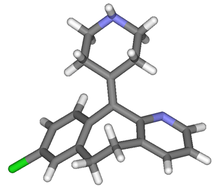Desloratadine
 | |
 | |
| Clinical data | |
|---|---|
| Trade names | Clarinex |
| AHFS/Drugs.com | Monograph |
| MedlinePlus | a602002 |
| License data |
|
| Pregnancy category | |
| Routes of administration | Oral |
| ATC code | R06AX27 (WHO) |
| Legal status | |
| Legal status | |
| Pharmacokinetic data | |
| Bioavailability | Rapidly absorbed |
| Protein binding | 85% |
| Metabolism | Hepatic |
| Biological half-life | 27 hours |
| Excretion |
40% as conjugated metabolites into urine Similar amount into the feces |
| Identifiers | |
| |
| CAS Number |
100643-71-8 |
| PubChem (CID) | 124087 |
| IUPHAR/BPS | 7157 |
| DrugBank |
DB00967 |
| ChemSpider |
110575 |
| UNII |
FVF865388R |
| KEGG |
D03693 |
| ChEBI |
CHEBI:291342 |
| ChEMBL |
CHEMBL1172 |
| ECHA InfoCard | 100.166.554 |
| Chemical and physical data | |
| Formula | C19H19ClN2 |
| Molar mass | 310.82 |
| 3D model (Jmol) | Interactive image |
| |
| |
| (verify) | |
Desloratadine is a tricyclic H1-antihistamine that is used to treat allergies. It is an active metabolite of loratadine.
Use
Desloratadine is used to treat allergic rhinitis and nasal congestion.[1] It is the major metabolite of loratadine and the two drugs are similar in safety and effectiveness.[1] Desloratadine is available in many dosage forms and under many trade names worldwide.[2]
An emerging indication for desloratadine is in the treatment of acne, as an inexpensive adjuvant to isotretinoin and possibly as maintenance therapy or monotherapy.[3][4]
Side effects
Most common side-effects are fatigue, dry mouth, headache, and gastrointestinal disturbances.[1]
Mechanism of action
Desloratadine is a selective H1-antihistamine which functions as an inverse agonist at the histamine H1 receptor;[5]
It is also an antagonist at all subtypes of the muscarinic acetylcholine receptors.
It exhibits only peripheral activity since it does not readily cross the blood-brain barrier; hence, it does not cause drowsiness because it does not readily enter the central nervous system.[6]
It has a long-lasting effect and is effective in moderate and low doses.
See also
References
- 1 2 3 See S (2003). "Desloratadine for allergic rhinitis". Am Fam Physician. 68 (10): 2015–6. PMID 14655812.
- ↑ Drugs.com Desloratadine entry at drugs.com international Page accessed May 4, 2015
- ↑ Lee HE, Chang IK, Lee Y, Kim CD, Seo YJ, Lee JH, Im M (2014). "Effect of antihistamine as an adjuvant treatment of isotretinoin in acne: a randomized, controlled comparative study". J Eur Acad Dermatol Venereol. 28 (12): 1654–60. doi:10.1111/jdv.12403. PMID 25081735.
- ↑ Layton AM (2016). "Top Ten List of Clinical Pearls in the Treatment of Acne Vulgaris". Dermatol Clin. 34 (2): 147–57. doi:10.1016/j.det.2015.11.008. PMID 27015774.
- ↑ Canonica GW, Blaiss M (2011). "Antihistaminic, anti-inflammatory, and antiallergic properties of the nonsedating second-generation antihistamine desloratadine: a review of the evidence". World Allergy Organ J. 4 (2): 47–53. doi:10.1097/WOX.0b013e3182093e19. PMC 3500039
 . PMID 23268457.
. PMID 23268457. - ↑ Mann R, Pearce G, Dunn N, Shakir S (2000). "Sedation with "non-sedating" antihistamines: four prescription-event monitoring studies in general practice". BMJ. 320 (7243): 1184–6. doi:10.1136/bmj.320.7243.1184. PMC 27362
 . PMID 10784544.
. PMID 10784544.